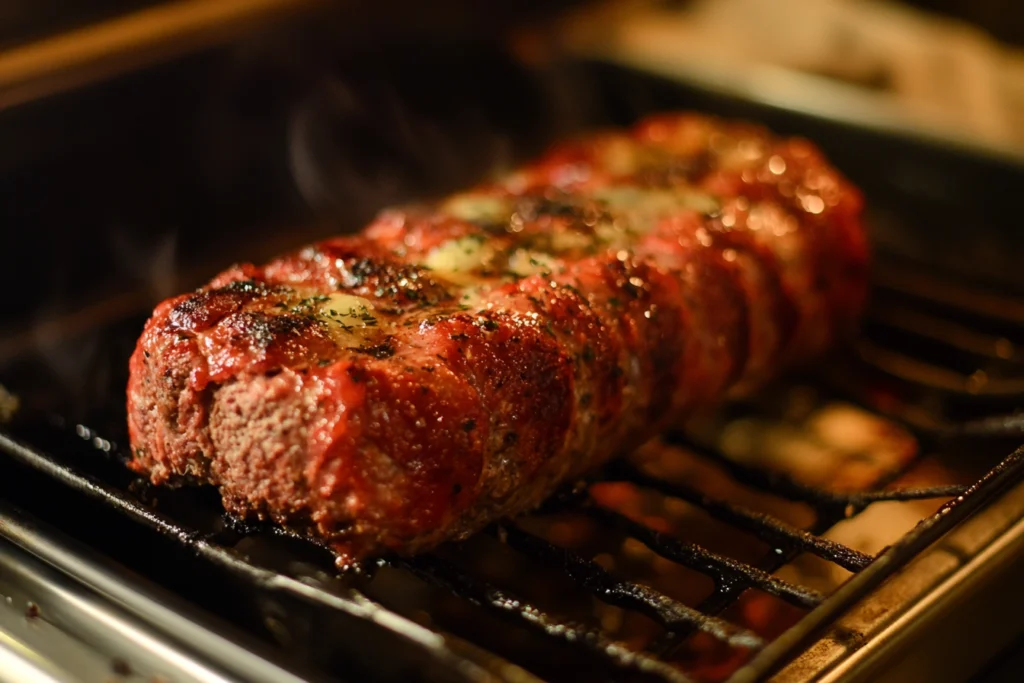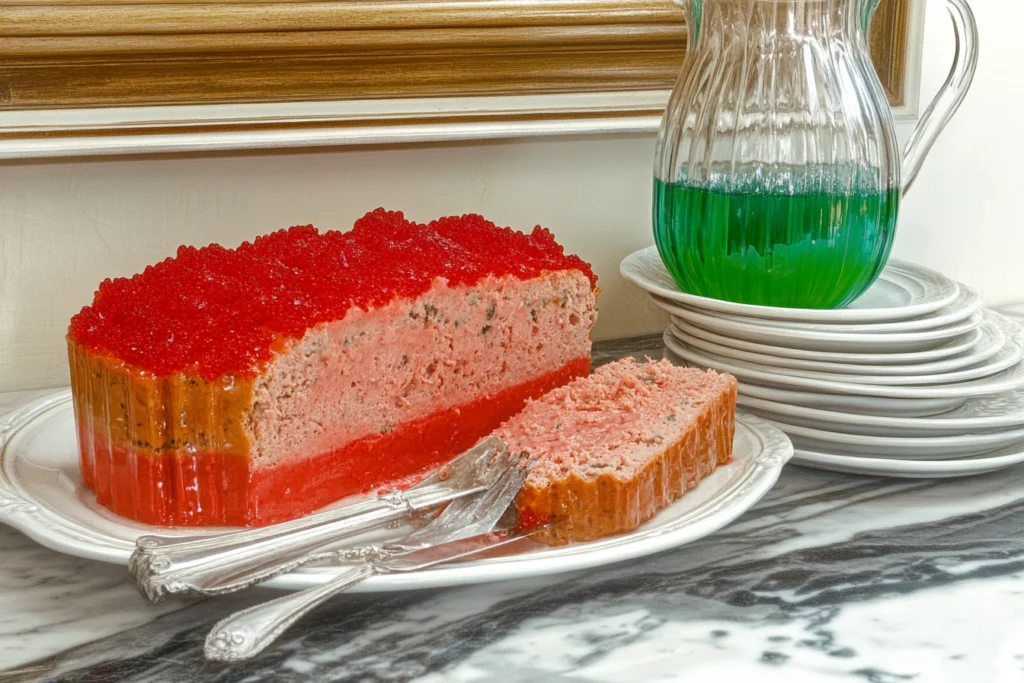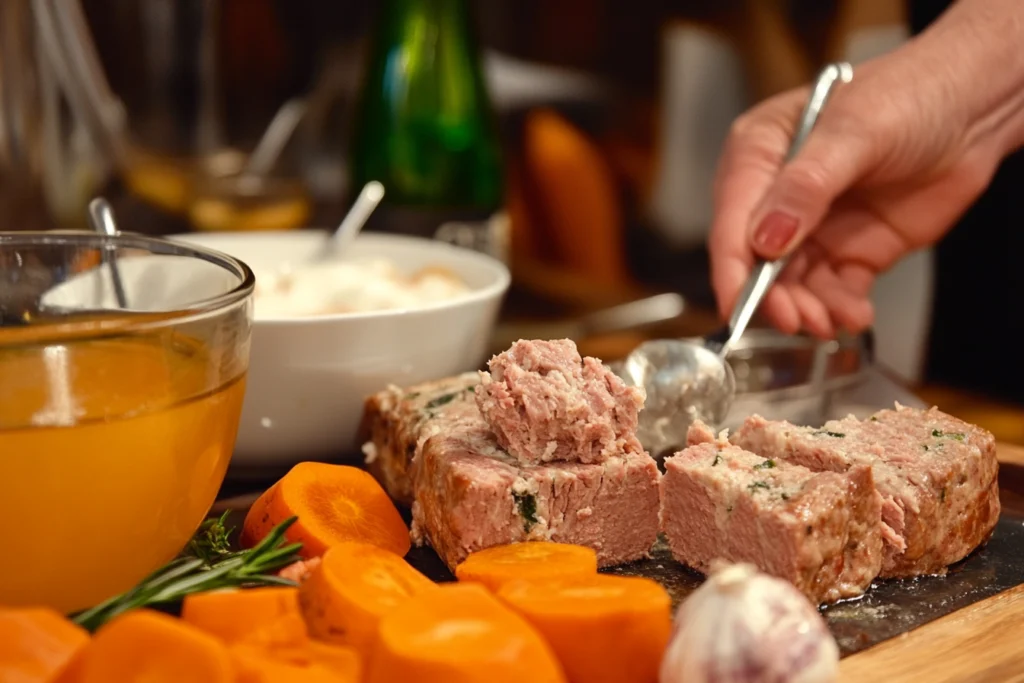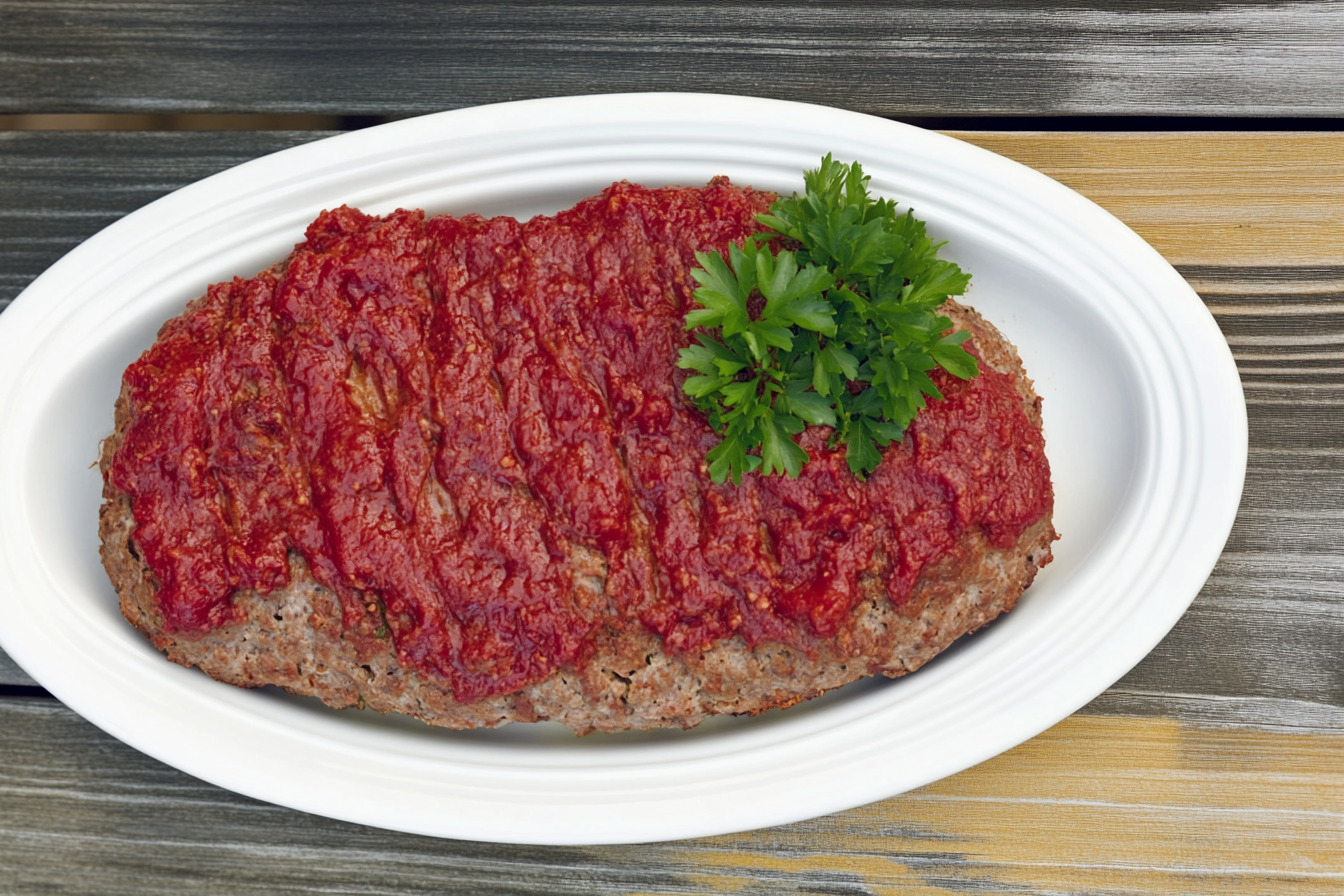Creating the perfect, juicy meatloaf is an art that combines the right ingredients, proper techniques, and a bit of culinary knowledge. This guide will take you through everything you need to know to master this comfort food classic.
Understanding the Basics of Meatloaf
What is Meatloaf?
Meatloaf, a beloved dish in homes around the world, is more than just a loaf-shaped concoction of meat. It originated as a frugal way to extend meat portions during hard times, making it an economical and versatile choice. Early versions of meatloaf can be traced back to ancient Roman recipes, but the dish gained its modern form in the 19th century in the United States.
It has since evolved into a flavorful combination of meats, binders, and seasonings, baked into a cohesive and satisfying loaf. Whether served as a centerpiece for dinner or as leftovers in sandwiches, meatloaf holds a special place in culinary history.
Common Ingredients in Meatloaf
The core components of a meatloaf include:
- Ground Meats: Typically beef, or turkey, with varying fat content.
- Binders: Ingredients like breadcrumbs, eggs, and oatmeal help hold the loaf together.
- Seasonings: Herbs, spices, salt, and pepper to enhance flavor.
- Moisture-Rich Elements: Milk, broth, or grated vegetables to prevent dryness.
Each ingredient plays a role in determining the texture, flavor, and moisture of the final product.
Importance of Moisture in Meatloaf
A dry meatloaf can ruin the dining experience. Moisture is the key to achieving that melt-in-your-mouth texture. Moisture retention impacts:
- Texture: Ensuring the meatloaf stays tender and soft.
- Flavor: Locking in the natural juices and seasoning.
Why Meatloaf Becomes Dry
Even with the best intentions, meatloaf can turn dry due to:
- Overcooking: High temperatures or extended baking times deplete moisture.
- Poor Ingredient Balance: Too much lean meat, insufficient binders, or lack of liquid.
Understanding these pitfalls can help prevent common mistakes and elevate your meatloaf game.
Choosing the Right Meat
Selecting the right ground meat is a pivotal step in ensuring a juicy result.
Fat-to-Lean Ratios
The fat content in the meat plays a critical role. A mix of:
- 80/20 ground beef (80% lean, 20% fat) offers the ideal balance of flavor and moisture.
- Ground turkey or chicken, while leaner, requires additional moisture-boosting ingredients.
Mixing Meats for Better Flavor
Combining meats like:
- Beef for richness,
- Veal for tenderness
creates a depth of flavor that is hard to achieve with a single type of meat.
Role of Binders in Juiciness
Binders are the glue that holds the meatloaf together while enhancing its texture and moisture content.
Eggs, Breadcrumbs, and Oatmeal
- Eggs: Add structure and richness.
- Breadcrumbs: Act as a sponge, soaking up liquids and releasing them during cooking.
- Oatmeal: Provides a hearty texture and is great for gluten-free options.
Dairy-Based Binders
Adding milk, cream, or buttermilk softens the breadcrumbs and gives the loaf a creamy texture.
Balancing Seasonings
Flavorful meatloaf hinges on the perfect blend of seasonings.
- Herbs and Spices: Garlic, thyme, parsley, and paprika add layers of flavor.
- Salt: Essential for enhancing natural meat flavors.
- Pepper: Provides a subtle kick.
Umami Boosters for Meatloaf
Adding umami-rich ingredients like:
- Tomato paste: Deepens the savory profile.
- Worcestershire sauce: Adds tangy and umami notes.
- Soy sauce: Enhances the natural meatiness.
Techniques for Achieving Juicy Meatloaf
Making juicy meatloaf isn’t just about the ingredients—it’s also about using the right techniques. From selecting moisture-retaining ingredients to mastering cooking methods, this section will guide you through every step.

The Role of Moisture-Retaining Ingredients
Moisture is the lifeblood of a perfect meatloaf. Incorporating certain ingredients ensures that the loaf remains tender and flavorful.
Adding Vegetables for Natural Moisture
Grated or finely chopped vegetables are a secret weapon for juicy meatloaf. They release water as the loaf cooks, adding a natural moistness. Popular choices include:
- Carrots: Subtle sweetness and natural water content.
- Onions: Enhance flavor while adding a moisture boost.
- Zucchini: Mild flavor and high water content, ideal for leaner meats.
These vegetables not only keep the meatloaf juicy but also improve its nutritional value.
Incorporating Liquids into the Mix
Liquids play a crucial role in maintaining the loaf’s texture. Consider adding:
- Broth: Chicken or beef broth infuses the meatloaf with rich flavor.
- Milk or Cream: Softens breadcrumbs and adds a luxurious texture.
- Tomato Sauce: Enhances umami while keeping the loaf moist.
The key is to add just enough liquid to prevent dryness without making the mixture too wet to shape.
Pre-Soaking Breadcrumbs
One effective method is to pre-soak breadcrumbs in liquid before mixing them into the meat. This step:
- Helps distribute moisture evenly.
- Prevents dense or dry spots in the loaf.
- Creates a smooth, uniform texture.

Optimal Mixing Methods
Mixing the meatloaf ingredients properly can make or break your final result.
Avoiding Overmixing
While it’s tempting to ensure everything is well combined, overmixing leads to:
- Tough meatloaf due to overworked proteins.
- Loss of the airy texture that defines a juicy loaf.
Instead, gently fold the ingredients until just combined.
Gentle Shaping Techniques
When forming the loaf:
- Avoid compacting it too tightly.
- Shape it gently to allow air pockets, which retain moisture during cooking.
These steps ensure the loaf cooks evenly while staying tender.
Perfect Cooking Techniques
Cooking meatloaf properly is crucial for locking in moisture.
Low and Slow Cooking
Cooking at a moderate temperature (around 325°F to 350°F) allows the meat to cook evenly while retaining its juices. High heat, on the other hand, can lead to a dry exterior and undercooked center.
Using a Water Bath
A water bath is a simple technique to retain moisture during baking:
- Place the loaf pan in a larger baking dish filled with hot water.
- The steam created prevents the loaf from drying out.
This method works exceptionally well for leaner meats like turkey or chicken.
Checking Internal Temperature
Invest in a good meat thermometer to avoid overcooking. The ideal internal temperature is:
- 160°F for beef
- 165°F for turkey or chicken.
Remove the meatloaf from the oven once it reaches these temperatures and let it rest.
Toppings and Glazes
A well-chosen glaze not only enhances flavor but also helps seal in moisture.
Moisture-Sealing Glazes
The classic ketchup glaze remains a favorite, but you can experiment with:
- BBQ Sauce: Smoky sweetness for a bold flavor.
- Tomato Jam: A tangy-sweet twist.
- Honey Mustard: Balances sweetness and tanginess.
Brush the glaze over the meatloaf during the final 10–15 minutes of baking to create a shiny, flavorful crust.
Creating Layered Toppings
For added texture and flavor, layer the glaze with:
- Caramelized onions.
- Crispy bacon strips.
- Melted cheese for an indulgent finish.
Advanced Tips and Variations for Juicy Meatloaf
To truly master the art of juicy meatloaf, exploring advanced tips and creative variations can make your dish stand out. This section dives into unique ideas, innovative techniques, and clever ways to elevate the classic meatloaf.
Creative Additions for Juicy Meatloaf
Adding unexpected ingredients can transform a standard meatloaf into a culinary masterpiece.
Cheese-Stuffed Meatloaf
For an indulgent twist, incorporate a cheesy center:
- Choosing the Cheese: Mozzarella, cheddar, or even blue cheese can create a rich, gooey core.
- Technique: Divide the meat mixture in half. Form the bottom layer, add a cheese layer, and then cover it with the remaining meat mixture.
- Benefits: The cheese not only adds flavor but also keeps the center moist as it melts during cooking.
Incorporating Bacon
Bacon adds a smoky flavor and a boost of fat to keep your meatloaf moist.
- Wrapping the Loaf: Lay strips of bacon over the top and sides of the loaf. They crisp up as the meatloaf cooks, creating a flavorful crust.
- Layering Inside: Dice bacon and mix it into the meat for a smoky surprise in every bite.

Experimenting with International Flavors
Bring a global twist to your meatloaf by incorporating seasonings and ingredients from different cuisines:
- Mediterranean Style: Add feta cheese, olives, and oregano for a tangy, savory flavor.
- Asian-Inspired: Use soy sauce, ginger, and sesame oil for a unique umami kick.
- Tex-Mex Flair: Incorporate jalapeños, cumin, and shredded cheese, and top with a salsa glaze.
These variations make your meatloaf not just a meal but an adventure.
Using Savory Fillings
Filling the meatloaf with savory ingredients adds both moisture and surprise:
- Mushrooms: Sautéed mushrooms bring a deep, earthy flavor.
- Spinach: Adds moisture and color while boosting nutrition.
- Sundried Tomatoes: Intensifies the flavor with a sweet and tangy punch.
Alternative Cooking Methods
Switching up the cooking method can help achieve consistently juicy results and add convenience.
Slow Cooker Meatloaf
Cooking meatloaf in a slow cooker is a hands-off approach that guarantees moisture retention.
- Steps:
- Line the slow cooker with foil or parchment for easy removal.
- Cook on low for 6–8 hours or high for 3–4 hours.
- Benefits: The slow, even cooking ensures the juices remain locked in, while the foil helps the loaf hold its shape.
Air Fryer Meatloaf
For a quicker cooking method, the air fryer delivers a juicy interior with a crispy exterior:
- Steps:
- Shape the meatloaf to fit the air fryer basket.
- Cook at 350°F for 25–30 minutes, flipping halfway for even browning.
- Benefits: This method reduces cooking time while maintaining a moist texture.
Storing and Reheating Tips
Proper storage and reheating techniques can ensure your leftover meatloaf remains as juicy as the day it was cooked.
Proper Storage for Moisture Retention
To store meatloaf without losing its texture:
- Refrigeration: Wrap the loaf tightly in plastic wrap or place it in an airtight container. Consume within 3–4 days.
- Freezing: Slice the meatloaf and freeze individual portions with parchment between layers to prevent sticking.
Reheating Meatloaf Without Drying It Out
Reheating correctly is essential to avoid a tough or dry texture:
- Microwave: Place slices in a microwave-safe dish with a damp paper towel on top. Heat in 30-second intervals.
- Oven: Cover the meatloaf with foil and bake at 300°F for 20–25 minutes.
- Stovetop: Warm slices in a covered skillet with a splash of broth or water.
Common Mistakes to Avoid
Avoiding common mistakes can make the difference between a dry, crumbly loaf and a moist, tender one.
Overpacking the Loaf
- Pressing the mixture too tightly can lead to a dense and dry texture.
- Instead, shape the loaf gently to maintain airflow and prevent compactness.
Skipping Rest Time
- Allowing the meatloaf to rest for at least 10 minutes after cooking is crucial.
- This step lets the juices redistribute, preventing them from spilling out when sliced.
FAQs: Ensuring Juicy and Perfect Meatloaf
- What’s the best meat ratio for meatloaf?
A mix of 80/20 ground beef and turkey, works best for balancing flavor and moisture. - Can I make meatloaf without breadcrumbs?
Absolutely! Substitutes like oats, crushed crackers, or almond flour are excellent alternatives. - How do I prevent my meatloaf from falling apart?
Ensure you’re using enough binders such as eggs and breadcrumbs. Avoid overmixing, which can weaken the structure. - What’s the best way to check if meatloaf is done?
Use a meat thermometer to confirm the internal temperature reaches 160°F for beef or 165°F for poultry. - Can I make meatloaf ahead of time?
Yes, prepare the meatloaf mixture in advance, refrigerate it, and bake it fresh when needed. - How do I make a gluten-free meatloaf?
Replace breadcrumbs with gluten-free options such as oats, crushed rice crackers, or almond meal. - Why does my meatloaf crack?
Cracking often occurs when the surface dries out. Applying a glaze or cooking at a moderate temperature can prevent this. - What’s the ideal size for a meatloaf?
A thickness of about 2–3 inches ensures even cooking without drying out the edges. - How do I add vegetables without making the loaf watery?
Sauté vegetables like zucchini or mushrooms to remove excess water before incorporating them into the mixture. - Is it necessary to rest meatloaf before slicing?
Yes! Letting the meatloaf rest for 10–15 minutes allows the juices to redistribute, ensuring every slice is moist and flavorful.
If you need further clarification or additional tips, feel free to ask!

